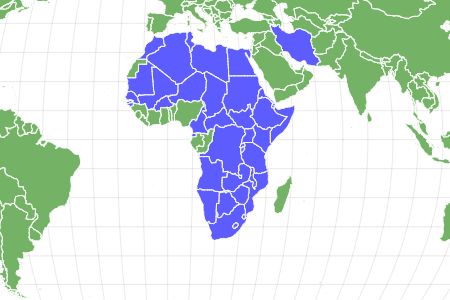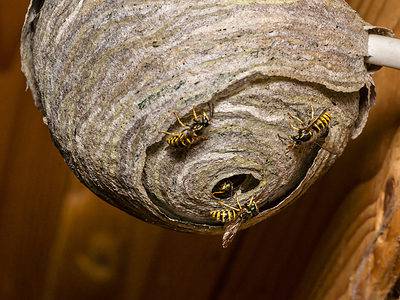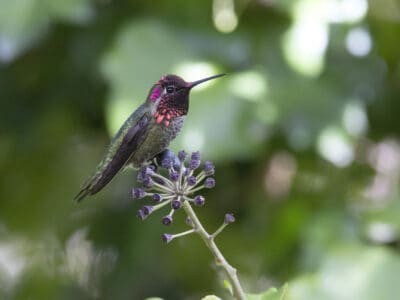Cheetah
Acinonyx jubatus
The fastest land mammal in the world!
Advertisement
Cheetah Scientific Classification
- Kingdom
- Animalia
- Phylum
- Chordata
- Class
- Mammalia
- Order
- Carnivora
- Family
- Felidae
- Genus
- Acinonyx
- Scientific Name
- Acinonyx jubatus
Read our Complete Guide to Classification of Animals.
Cheetah Conservation Status
Cheetah Facts
- Prey
- Gazelle, Wildebeest, Hare
- Name Of Young
- Cub
- Group Behavior
- Solitary/Pairs
- Fun Fact
- The fastest land mammal in the world!
- Estimated Population Size
- 8,500
- Biggest Threat
- Habitat loss
- Most Distinctive Feature
- Yellowish fur covered in small black spots
- Gestation Period
- 90 days
- Habitat
- Grasslands, semi-desert prairies, and mountainous terrain
- Diet
- Carnivore
- Average Litter Size
- 3
- Lifestyle
- Diurnal
- Common Name
- Cheetah
- Number Of Species
- 5
- Location
- Asia and Africa
- Slogan
- The fastest land mammal in the world!
- Group
- Mammal
Cheetah Physical Characteristics
- Color
- Brown
- Yellow
- Black
- Tan
- Skin Type
- Fur
- Top Speed
- 70 mph
- Lifespan
- 10 - 12 years
- Weight
- 40kg - 65kg (88lbs - 140lbs)
- Height
- 115cm - 136cm (45in - 53in)
- Age of Sexual Maturity
- 20 - 24 months
- Age of Weaning
- 3 months
View all of the Cheetah images!
Classification and Evolution
Known for their great speed, cheetahs are large and powerful felines that was once found throughout Africa, Asia, and even in parts of Europe. Due to civilization encroaching into their habit and hunting them for fur, the cheetah is now only found in remote areas in Africa and Iran.
Cheetahs, with the jaguarundi and the puma, descended from the puma lineage of the Felidae family. There is some debate about where and when it evolved because there is evidence of them in the Americas; however, others say they evolved after their ancestors had moved to the “Old World” of Africa and Asia.
Although they are not considered to be part of the ‘big cat’ family as they cannot roar, Cheetahs are one of Africa‘s most powerful predators and are most renowned for their immense speed when in a chase. Capable of reaching speeds of more than 60mph for short periods of time, the Cheetah is the fastest land mammal in the world. Learn about the world’s fastest animals here.
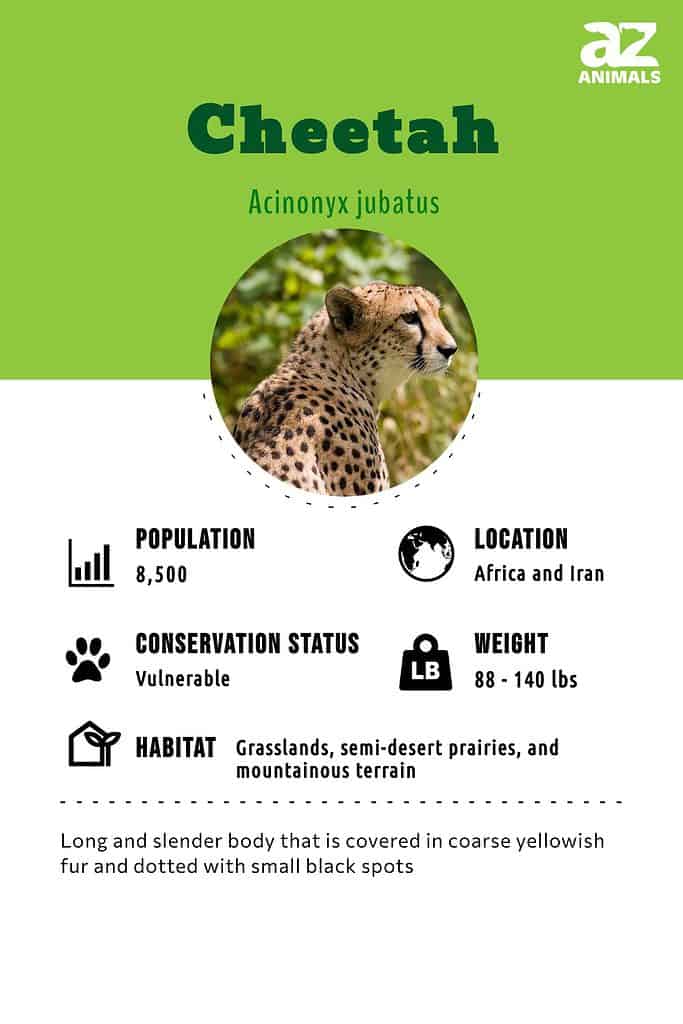
Anatomy and Appearance
The Cheetah is an animal that has a long and slender body that is covered in coarse yellowish fur and dotted with small black spots. Its long tail helps with balance and changing direction quickly and unlike the rest of the Cheetah’s body, there are ringed markings along the tail which ends in a black tip. Cheetahs have small heads with high-set eyes that aid them when surveying the surrounding grasslands for potential prey. They also have distinctive black “tear marks” that run from the inner eye, along their nose, and down to the outside of their mouths, which are thought to help protect them from being blinded by the bright sun. The exceptional speed of the Cheetah is caused by a number of things including having strong and powerful hind legs, and an incredibly flexible and muscular spine which allows the Cheetah to not only sprint quickly but also makes them very agile. They also have non-retractable claws which dig into the ground, giving the Cheetah a better grip at high speed.
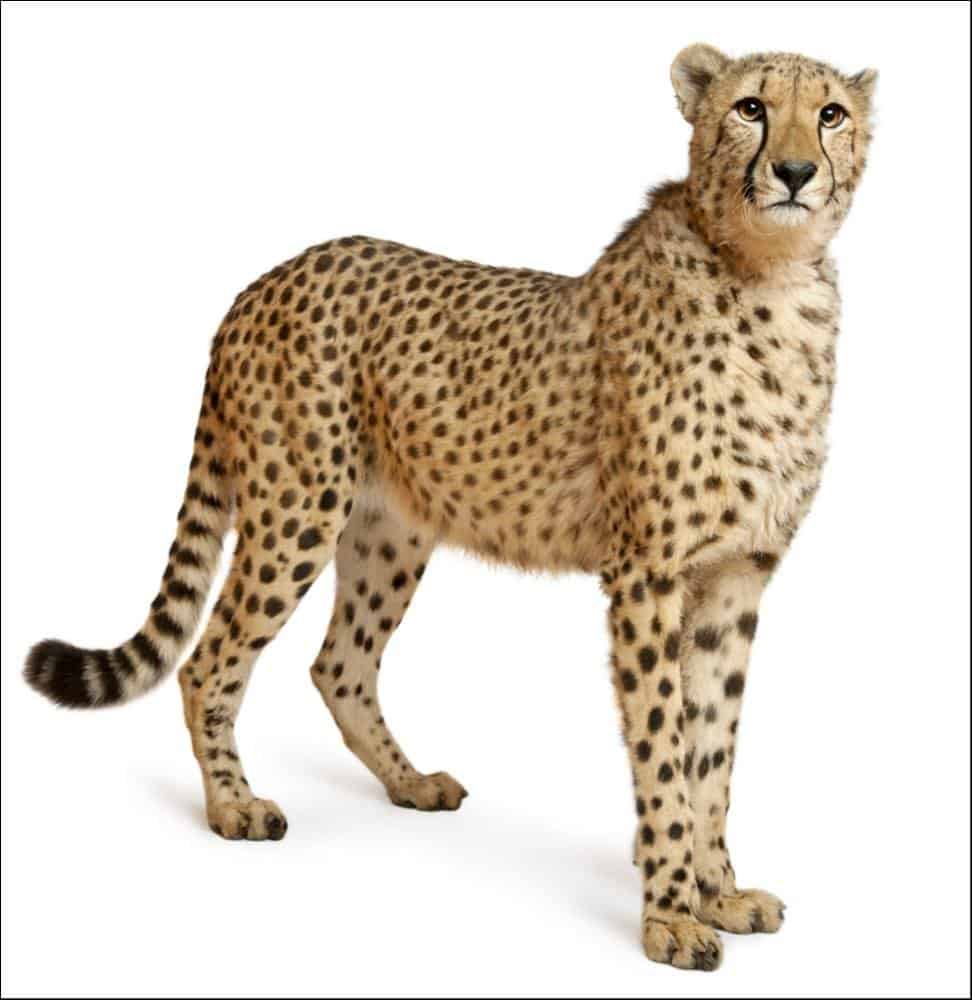
The Cheetah is long, slender, and covered in coarse yellowish fur, dotted with small black spots.
©Eric Isselee/Shutterstock.com
Distribution and Habitat
The Cheetah is an animal that once had a vast historical range that stretched across a number of continents, but their distribution today is much more scattered with a small number found in Iran and the majority found in sub-Saharan Africa. Although Cheetahs are still found in a few different parts of eastern and southern Africa, the highest population of wild Cheetahs is now found in Namibia in southwestern Africa. Cheetahs are most commonly found stalking prey on the vast, open grasslands but they are also found in a variety of other habitats as well including deserts, dense vegetation, and mountainous terrain, providing that there are adequate supplies of food and water. Cheetahs are one of Africa’s most vulnerable felines with population numbers being mainly affected by growing Human settlements that encroach on their native habitats.
5 Types of Cheetahs
- Northwest African (Saharan) Cheetah – The Northwest African (Saharan) Cheetah is a little bit smaller than its cousins, with a light-colored fur coat. Its spots drift from brown to black going toward the top of its back. The cheetah “tear stripes” are not always present.
- Northeast African (Somali) Cheetah – The Northeast African (Somali) Cheetah is one of the larger subspecies. It has a more coarse fur coat than some of its relatives and is overall the darkest in color. They also have a distinct white stomach and a thicker tail.
- Asiatic (Iranian) Cheetah – The Asiatic (Iranian) Cheetah is regrettably the only remaining cheetah in Asia. Their mane and overall coat are not as long as the African cheetahs. The sides of this cheetah are pale and gain color on the back. Their tail tips have black stripes.
- East African (Tanzanian) Cheetah – The East African (Tanzanian) Cheetah is a little slighter than its cousins. As one of the paler cheetahs, their coat tends to be tan or beige. This cheetah’s “tear stripes” are a little more pronounced than others, and its tail has black rings on its tail that ends with a white tip.
- South African (Nambian) Cheetah – The South African (Nambian) Cheetah is the nominate subspecies. They have a golden, somewhat thicker coat. This cheetah’s “tear marks” are wider at near the mouth and usually have brown mustache characteristics.
Behavior and Lifestyle
The Cheetah is unique amongst Africa’s felines primarily because they are most active during the day, which avoids competition for food from other large predators like Lions and Hyenas that hunt during the cooler night. They are also one of the more sociable Cat species with males often roaming in small groups, generally with their siblings, and oddly enough, it is the females that are more solitary animals apart from the 18 months or so that they spend looking after their cubs. Cheetahs are fiercely territorial animals that patrol large home ranges and often overlap those of other Cheetahs, and indeed Lions, with females tending to roam across a much larger range than males. They are typically shy and very stealthy animals so they are able to hunt for prey in the hot daylight hours without being spotted so easily.
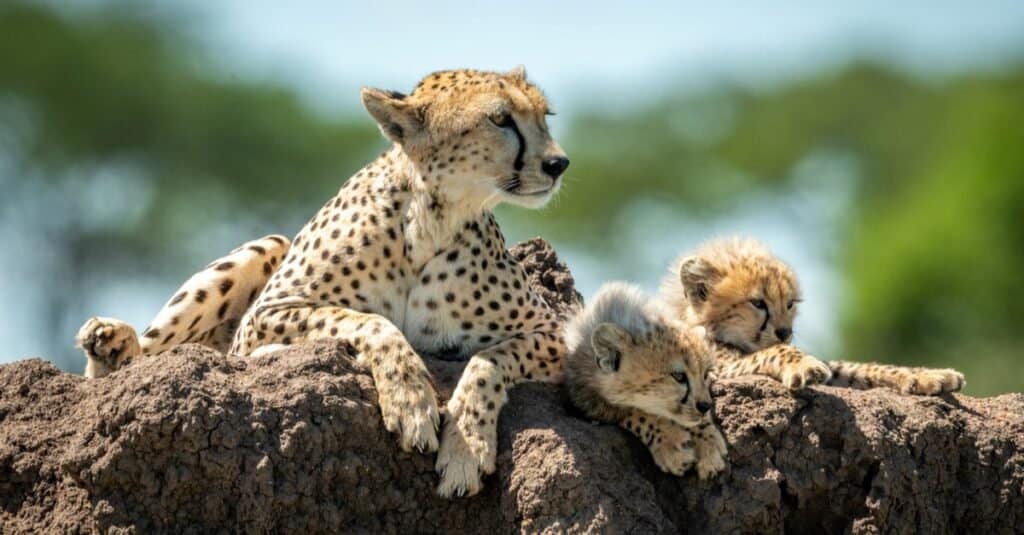
Cheetahs are one of the more sociable cat species.
©iStock.com/nicholas_dale
Reproduction and Life Cycles
After a gestation period that lasts for around 3 months, the female Cheetah gives birth to between two and five baby cheetah cubs that are born blind and incredibly vulnerable in the African wilderness. The cubs suckle from their mother for the first few months when they begin eating meat and start to accompany her on hunting trips as they are able to learn how to hunt from watching her. Cheetah cubs learn the majority of their hunting techniques through playing with their siblings and remain with their mother until they can hunt successfully and leave to find their own territory at between 18 months and 2 years old. Sadly, one of the main reasons for such drastic declines in Cheetah numbers is that up to 75% of Cheetah cubs don’t live to be older than 3 months, as their mother has to leave them every day to find food to feed them, leaving the vulnerable cubs helpless in the face of predators.
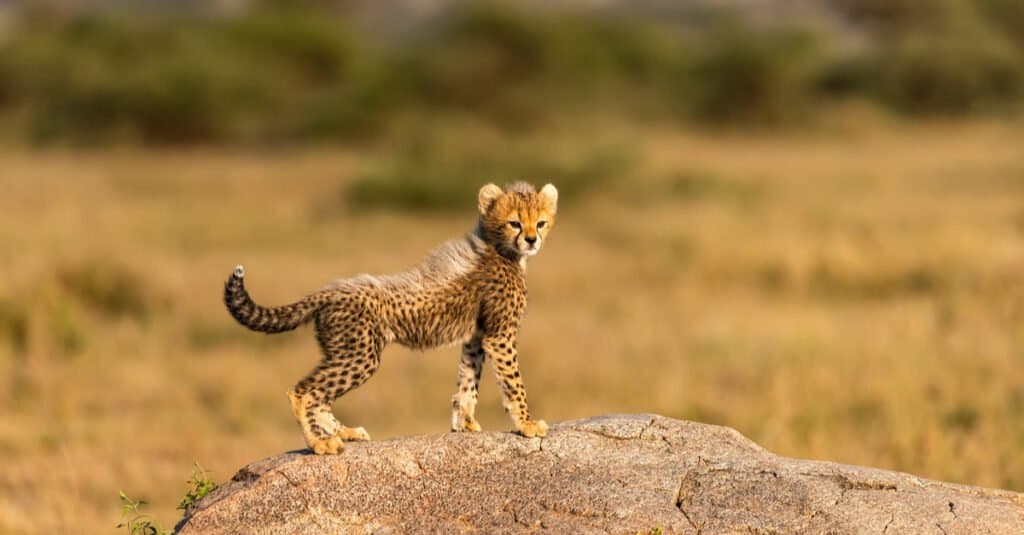
Cheetahs typically leave their to venture on their own between 18 months and 2 years old.
©Danita Delimont/Shutterstock.com
Diet and Prey
The Cheetah has exceptional eyesight and so hunts using sight by first stalking its prey (from between 10 to 30 meters away), and then chasing it when the time is right. Cheetahs often kill their prey in vast open spaces but tend to drag it into a hiding place to prevent it from being scavenged by other animals. The Cheetah has to do this as it cannot eat its prey straight away, due to the fact that they are immensely hot after the chase and need time to cool down before it can feast. Cheetahs are carnivorous animals meaning that they only hunt and kill other animals in order to get the nutrition that they need to survive. They mainly hunt large herbivores including Gazelle and a number of large Antelope species such as Wildebeest, along with Zebras and smaller mammals like Hares. The exact diet of the Cheetah though tends to depend on its location.
Predators and Threats
The adult Cheetah is a dominant predator in its environment and is therefore not seen as prey (more as competition) by other large predators. The Cheetah cubs however are incredibly vulnerable particularly when their mother is off hunting, and are preyed upon by a number of animals including Lions and Hyenas, but also large avian species such as Eagles and Vultures. The biggest threat to Cheetahs is people, who have not only taken vast areas of its natural habitat for themselves but have also turned large regions of land into National Parks. Although these areas seem to be showing increases in both Lion and Hyena populations, Cheetah numbers are much lower as there is more competition for food with the increasing numbers of these other large predators.
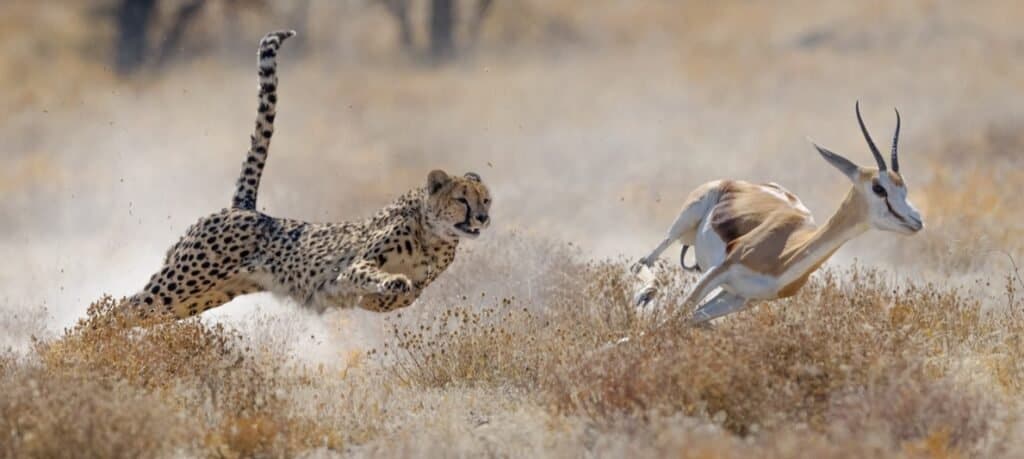
The adult Cheetah is a dominant predator in its environment.
©Elana Erasmus/Shutterstock.com
Cheetah Interesting Facts and Features
One of the most distinctive differences between the different subspecies is that their fur color changes slightly, depending on their surrounding environment. Those Cheetahs found in the more arid desert regions tend to be lighter and have smaller spots than those that roam the south African grasslands, and are darker, slightly bigger, and have larger spots. Although Cheetahs cannot roar, they do make a variety of different sounds including a high-pitched yelp which can be heard from more than a mile away. The Cheetah is one of the most distinctive of the world’s felines and although it is fairly commonly confused with the Leopard, its name is thought to have come from the Hindu word ‘chita’ which means the ‘spotted one’.
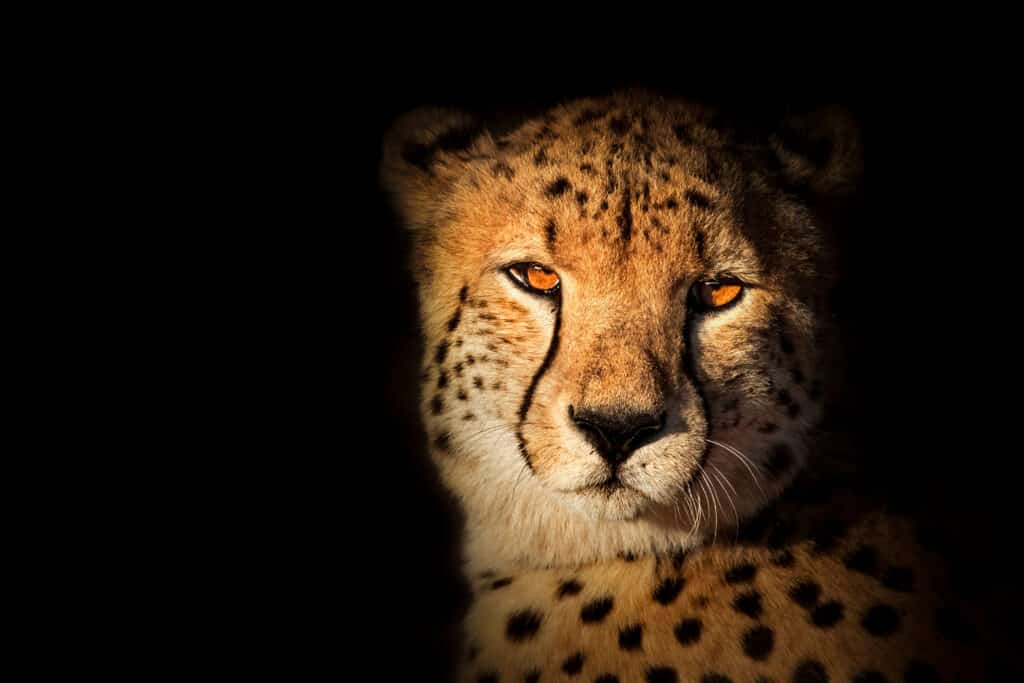
The name cheetah is thought to have come from the Hindu word ‘chita’ which means the ‘spotted one’.
©Henrico Muller/Shutterstock.com
Relationship with Humans
Despite their fierce appearance, Cheetahs have actually been domesticated by local people for thousands of years, as they were used to help with hunting for food for the villagers. They have also been kept in captivity for a long time, but as they do not seem to produce particularly healthy individuals, wild Cheetahs were regularly caught to restore the bloodline. Hunted by people as trophies throughout much of their natural range, Cheetahs have completely disappeared from numerous places, and along with habitat loss to growing Human settlements and the clearing of land for agriculture, Cheetah numbers are still declining rapidly in many areas today.
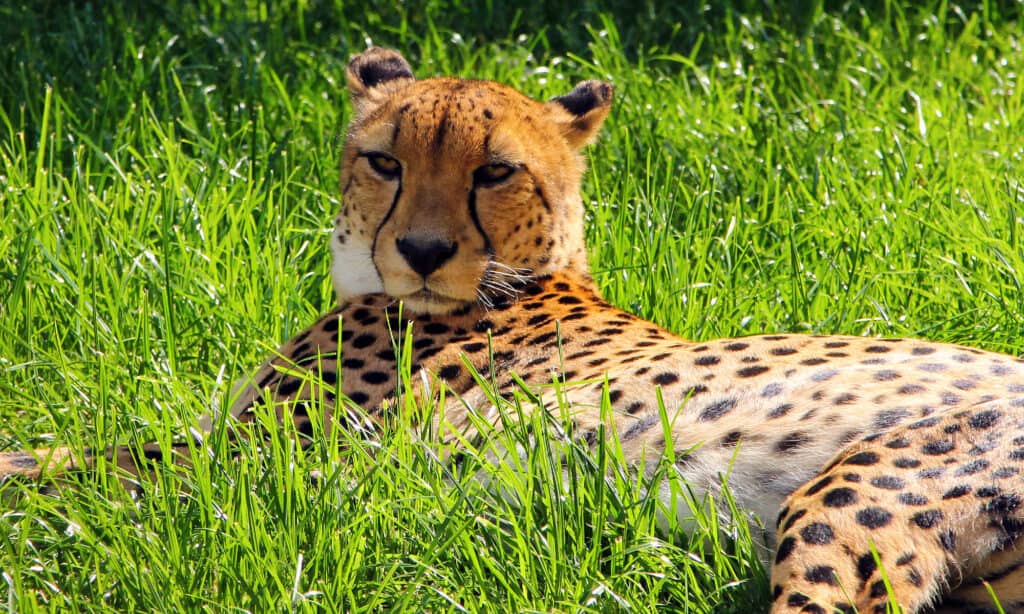
The Asiatic cheetah is genetically related, but distinct, from the African cheetah. Historically, these cheetahs were used by Indian royal families to hunt gazelles and antelope.
©Katoosha/Shutterstock.com
Conservation Status and Life Today
Today, the Cheetah has been listed by the IUCN as a species that is Vulnerable to extinction in its natural environment in the near future. Habitat loss along with the increase of natural parks that are home to a large number of competing predators has led to drastic declines in the world’s Cheetah population. There are now estimated to be about 7,000 individuals left in the wild, along with a growing number being found in zoos and animal institutes all over the world.
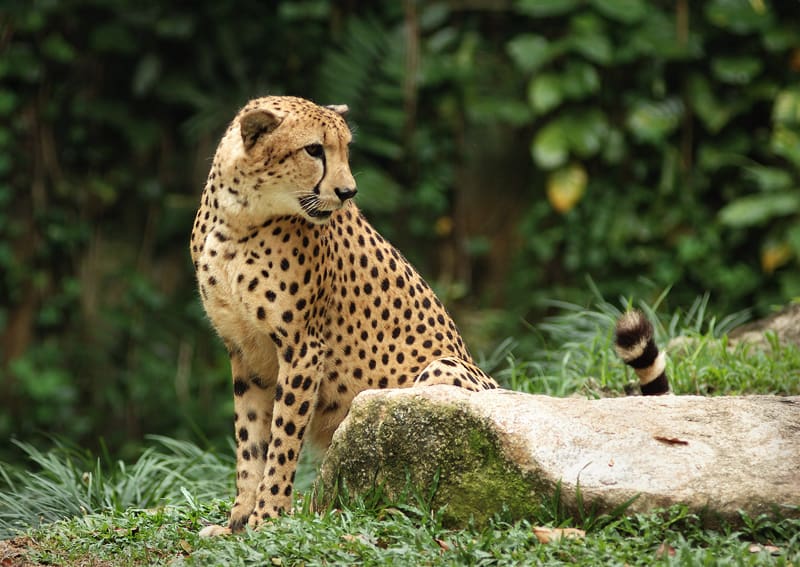
Cheetahs can be found in zoos all across the world.
©PlasticTV, CC BY-SA 3.0, via Wikimedia Commons – License
Cheetah FAQs (Frequently Asked Questions)
Are Cheetahs faster than greyhounds?
Yes, cheetahs are faster than greyhounds over short distances. When comparing a cheetah vs. greyhound, cheetahs can attain a maximum speed of more than 60 miles per hour while greyhounds have a maximum speed that’s only slightly above 40 miles per hour. However, greyhounds are long-distance runners that can maintain speed for more than 5 miles while cheetahs run in bursts rarely lasting more than 30 seconds.
Are Cheetahs herbivores, carnivores, or omnivores?
Cheetahs are Carnivores, meaning they eat other animals.
What Kingdom do Cheetahs belong to?
Cheetahs belong to the Kingdom Animalia.
What phylum do Cheetahs belong to?
Cheetahs belong to the phylum Chordata.
What class do Cheetahs belong to?
Cheetahs belong to the class Mammalia.
What family do Cheetahs belong to?
Cheetahs belong to the family Felidae.
What order do Cheetahs belong to?
Cheetahs belong to the order Carnivora.
What genus do Cheetahs belong to?
Cheetahs belong to the genus Acinonyx.
What type of covering do Cheetahs have?
Cheetahs are covered in Fur.
Where do Cheetahs live?
Cheetahs live in Asia and Africa.
In what type of habitat do Cheetahs live?
Cheetahs live in open grasslands.
What are some predators of Cheetahs?
Predators of Cheetahs include humans, lions, and eagles.
What is the average litter size for a Cheetah?
The average litter size for a Cheetah is 3.
What is an interesting fact about Cheetahs?
The Cheetah is the fastest land mammal in the world!
What is the scientific name for the Cheetah?
The scientific name for the Cheetah is Acinonyx jubatus.
What is the lifespan of a Cheetah?
Cheetahs can live for 10 to 12 years.
What is a baby Cheetah called?
A baby Cheetah is called a cub.
How many species of Cheetah are there?
There are 5 species of Cheetah.
What is the biggest threat to the Cheetah?
The biggest threat to the Cheetah is habitat loss.
How many Cheetahs are left in the world?
There are 8,500 Cheetahs left in the world.
How fast is a Cheetah?
A Cheetah can travel at speeds of up to 70 miles per hour.
Who would win in a race: a cheetah, or Usain Bolt?
A cheetah would win in a race against Usain Bolt. Given their top speeds and overall agility, cheetahs far outclass humans in general. However, Usain Bolt may have more endurance than a cheetah, given their ability to only run short distances.
What is the difference between a cheetah and a serval?
While the serval and the cheetah might look indistinguishable because of their fur coloration, we can differentiate these cats through their size, morphology, and behavior. Moreover, both cats belong to the same Felidae family, which houses the caracal, golden cat, and savannah cat.
Which is faster: the cheetah vs pronghorn?
The difference between the pronghorn and the cheetah in terms of speed is that the cheetah dominates over a short distance (sprint), while the pronghorn dominates over a long distance (marathon).
How to say Cheetah in ...
Thank you for reading! Have some feedback for us? Contact the AZ Animals editorial team.
Sources
- David Burnie, Dorling Kindersley (2011) Animal, The Definitive Visual Guide To The World's Wildlife
- Tom Jackson, Lorenz Books (2007) The World Encyclopedia Of Animals
- David Burnie, Kingfisher (2011) The Kingfisher Animal Encyclopedia
- Richard Mackay, University of California Press (2009) The Atlas Of Endangered Species
- David Burnie, Dorling Kindersley (2008) Illustrated Encyclopedia Of Animals
- Dorling Kindersley (2006) Dorling Kindersley Encyclopedia Of Animals
- David W. Macdonald, Oxford University Press (2010) The Encyclopedia Of Mammals

